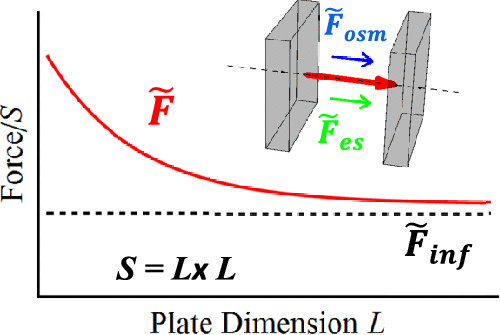Our official English website, www.x-mol.net, welcomes your feedback! (Note: you will need to create a separate account there.)
Numerical Studies on Electrical Interaction Forces and Free Energy between Colloidal Plates of Finite Size.
Langmuir ( IF 3.9 ) Pub Date : 2019-12-30 , DOI: 10.1021/acs.langmuir.9b02981 Hideatsu Maeda 1 , Yoshiko Maeda 2
Langmuir ( IF 3.9 ) Pub Date : 2019-12-30 , DOI: 10.1021/acs.langmuir.9b02981 Hideatsu Maeda 1 , Yoshiko Maeda 2
Affiliation

|
By solving the nonlinear Poisson-Boltzmann (PB) equation with a finite element method (FEM), three-dimensional (3D) spatial distributions of the electric potential (ψ, scaled) in electrolyte solutions having two charged parallel finite plates (including cubes and prismatic rods) are determined for various separations (d, scaled by the Debye length, κ-1), surface potentials (ψs), and plate dimensions (length × width × thickness, each scaled by κ-1). The total interaction force between two plates, F, is the sum of the electrostatic double-layer (EDL) repulsion (the osmotic pressure, Fosm) and the Maxwell electrostatic stress (Fes). The EDL repulsion is estimated using the distribution of ψ not only between the facing surfaces of two parallel plates but also around the other extremities of the plates. The Maxwell stress (Fes) is localized near the extremities to act as a repulsive force on the midplane between the two plates. The ratio Fes/F is 0.07-0.5, depending on d, ψs, and dimensions. It is found that, with increasing dimensions, the total F values per unit area calculated for finite plates, F̃, decreasingly approach the exact ones for parallel infinite plates, F̃inf; for example, at d = 1 and ψs = 5, the ratio F̃/F̃inf is 2.83 for plates with dimensions of 1 × 1 × 1 and 1.18 for plates of 10 × 10 × 1. The repulsions arising from the extremities cannot be neglected for plates with dimensions <10 × 10 × 1. Furthermore, the total interaction forces (F) are calculated at a series of discrete d values, respectively, for parallel plates. We introduce a force fitting function, Ff(d), with parameters that can be determined so that Ff(d) fits well to the calculated serial F values. By integrating the Ff(d), we obtain the interaction free energy, G(d), for finite parallel plates that consists of two Γ functions.
中文翻译:

有限尺寸胶体板之间电相互作用力和自由能的数值研究。
通过使用有限元方法(FEM)求解非线性Poisson-Boltzmann(PB)方程,可在具有两个带电平行有限板(包括立方体和确定各种分离度(d,按德拜长度κ-1缩放),表面电势(ψs)和板尺寸(长×宽×厚,均用κ-1缩放)确定棱柱形杆)。两块板之间的总相互作用力F为静电双层(EDL)排斥力(渗透压Fosm)和麦克斯韦静电应力(Fes)之和。EDL斥力不仅使用ψ在两个平行板的相对表面之间的分布,而且还使用板的其他末端周围的分布进行估算。麦克斯韦应力(Fes)位于四肢附近,在两块板之间的中平面上充当排斥力。Fes / F比为0.07-0.5,具体取决于d,ψs和尺寸。可以发现,随着尺寸的增加,有限板的单位面积总F值F̃逐渐减小,而平行无限板的精确F值F̃inf逐渐减小。例如,在d = 1且ψs= 5时,尺寸为1×1×1的板的F̃ / F̃inf比为2.83,而对于10×10×1的板的比率为1.18。尺寸小于10×10×1的板。此外,对于平行板,总相互作用力(F)分别在一系列离散d值下计算。我们介绍一个力拟合函数Ff(d),带有可以确定的参数,以使Ff(d)非常适合计算的序列F值。通过积分Ff(d),我们获得了由两个Γ函数组成的有限平行板的相互作用自由能G(d)。
更新日期:2019-12-31
中文翻译:

有限尺寸胶体板之间电相互作用力和自由能的数值研究。
通过使用有限元方法(FEM)求解非线性Poisson-Boltzmann(PB)方程,可在具有两个带电平行有限板(包括立方体和确定各种分离度(d,按德拜长度κ-1缩放),表面电势(ψs)和板尺寸(长×宽×厚,均用κ-1缩放)确定棱柱形杆)。两块板之间的总相互作用力F为静电双层(EDL)排斥力(渗透压Fosm)和麦克斯韦静电应力(Fes)之和。EDL斥力不仅使用ψ在两个平行板的相对表面之间的分布,而且还使用板的其他末端周围的分布进行估算。麦克斯韦应力(Fes)位于四肢附近,在两块板之间的中平面上充当排斥力。Fes / F比为0.07-0.5,具体取决于d,ψs和尺寸。可以发现,随着尺寸的增加,有限板的单位面积总F值F̃逐渐减小,而平行无限板的精确F值F̃inf逐渐减小。例如,在d = 1且ψs= 5时,尺寸为1×1×1的板的F̃ / F̃inf比为2.83,而对于10×10×1的板的比率为1.18。尺寸小于10×10×1的板。此外,对于平行板,总相互作用力(F)分别在一系列离散d值下计算。我们介绍一个力拟合函数Ff(d),带有可以确定的参数,以使Ff(d)非常适合计算的序列F值。通过积分Ff(d),我们获得了由两个Γ函数组成的有限平行板的相互作用自由能G(d)。


























 京公网安备 11010802027423号
京公网安备 11010802027423号